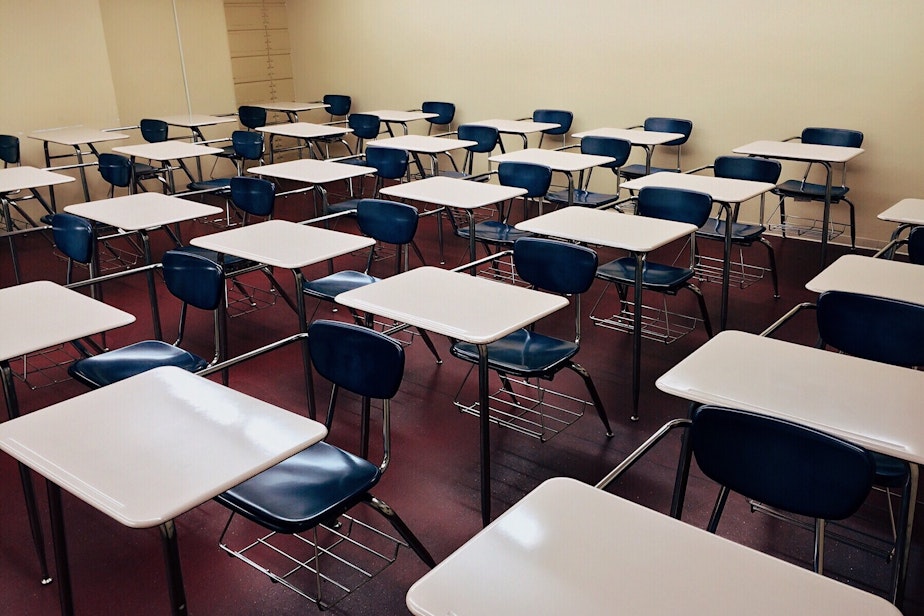What will school look like this fall in the Seattle area?

KUOW All Things Considered host Kim Malcolm interviews education reporter Ann Dornfeld.
It’s the last week of a very unusual school year in many Washington districts. Schools have been closed since March due to the coronavirus, which forced teachers and families to quickly shift to distance learning -- something few had ever done before.
Looking ahead, school districts across Washington recently got a primer on starting classes in the fall from the Office of the Superintendent of Public Instruction.
Ann Dornfeld: State Superintendent of Public Instruction Chris Reykdal said that districts should plan to hold classes in-person this fall if allowed by public health officials. But he said each district will need its own plan for how to bring students back to school while minimizing risk.
The goal is for students and staff to all wear masks and to maintain six feet of social distancing -- which is tricky when classes often have 25 or 35 students.
To keep enough space between students, districts could have students on A/B schedules, with half of a class coming, say, Mondays and Tuesdays, and the other half coming Thursdays and Fridays.
Sponsored
Districts might have the school year start in phases, starting with elementary students. Or elementary classes could spread out and use middle and high schools.
The expectation is that if classes are only in-person part-time or less, that districts make sure that students are doing remote learning the rest of the time.
And Reykdal said that districts need to be ready to pivot to 100% distance learning if schools can’t open on time or need to close because of Covid outbreaks.
Kim Malcolm: How realistic is the expectation to keep kids six feet apart?
Well, the key is harm reduction. So the state’s social distancing guidelines come from the Department of Health, which worked with OSPI to develop school rules. The health department says schools should maintain social distancing as much as possible -- so desks facing forward instead of each other, meals in classrooms rather than cafeterias, no assemblies or field trips, etc.
Sponsored
Obviously, six feet is impossible to maintain with kids, but schools are supposed to do what they can to maximize social distancing with the acknowledgment that different age groups are capable of different levels of adherence.
Any signs yet on what school might look like next fall in Seattle?
The district is considering two plans. One is having elementary students attend in-person full-time, with part-time in-person classes for middle and high school students on an A/B schedule. The other plan would have all students attending part-time on an A/B schedule, and remote learning the rest of the time.
Superintendent Denise Juneau has said that the district is working quickly in collaboration with stakeholders including the teachers’ union to come up with the best plan for fall. It's supposed to be announced this Friday, the last day of school.
Teachers are weighing on the the issue.
Sponsored
The teachers’ union released a statement Monday night saying that the superintendent was rushing the process and not leaving time for negotiation.
Whatever the district announces, it will need to bargain the details with the union over the summer. And of course part of the bargaining will be over what full-time distance learning would look like next year if schools are all closed again due to a Covid flare-up.
Distance learning is a challenge. Do we know how kids are doing as they learn this way? Any analysis on distance learning?
Having spoken with a lot of parents at this point about how distance learning has gone in their homes, and given that the plural of anecdotes is, in fact, data - the situation is not good.
I also spoke with a dozen Seattle teachers for a recent story about what they were seeing in terms of student engagement, and got a pretty bleak picture. In lower-income classrooms, I heard from a lot of teachers who were only seeing about one-third of their students taking part in schoolwork.
Sponsored
There's a wide range of reasons for that, like lack of internet access or laptops. Younger students, especially, need help doing distance learning but don’t always have someone home who can help them.
A lot of students have been taking care of younger family members or working outside the home, and many kids have disabilities that makes distance learning extra challenging or impossible given the lack of in-person supports.
And then even for families who have everything they theoretically need, as you and I have both found, Kids don’t always relish their parents as schoolmasters. So some parents have just opted out and said they’re going to do their own thing or let their kids just learn organically.
Some districts have been trying to track student engagement in order to figure out how to improve distance learning for next year. But in Seattle, the district told me that they were not tracking whether students were coming to online classes or doing any schoolwork - so it’s not clear what data they’ll be using to improve distance learning for the fall.
This interview has been lightly edited for clarity.





